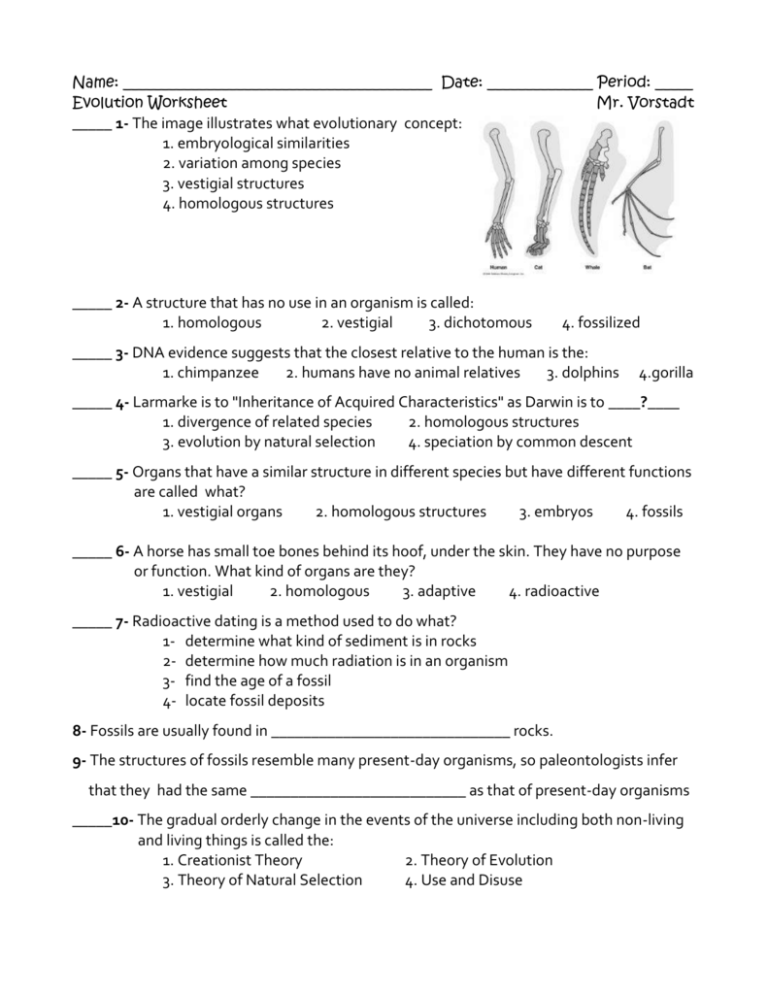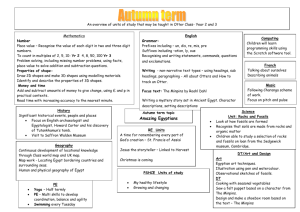Evolution Worksheet
advertisement

Name: _________________________________________ Date: ______________ Period: _____ Evolution Worksheet Mr. Vorstadt _____ 1- The image illustrates what evolutionary concept: 1. embryological similarities 2. variation among species 3. vestigial structures 4. homologous structures _____ 2- A structure that has no use in an organism is called: 1. homologous 2. vestigial 3. dichotomous 4. fossilized _____ 3- DNA evidence suggests that the closest relative to the human is the: 1. chimpanzee 2. humans have no animal relatives 3. dolphins 4.gorilla _____ 4- Larmarke is to "Inheritance of Acquired Characteristics" as Darwin is to ____?____ 1. divergence of related species 2. homologous structures 3. evolution by natural selection 4. speciation by common descent _____ 5- Organs that have a similar structure in different species but have different functions are called what? 1. vestigial organs 2. homologous structures 3. embryos 4. fossils _____ 6- A horse has small toe bones behind its hoof, under the skin. They have no purpose or function. What kind of organs are they? 1. vestigial 2. homologous 3. adaptive 4. radioactive _____ 7- Radioactive dating is a method used to do what? 1- determine what kind of sediment is in rocks 2- determine how much radiation is in an organism 3- find the age of a fossil 4- locate fossil deposits 8- Fossils are usually found in ______________________________ rocks. 9- The structures of fossils resemble many present-day organisms, so paleontologists infer that they had the same ___________________________ as that of present-day organisms _____10- The gradual orderly change in the events of the universe including both non-living and living things is called the: 1. Creationist Theory 2. Theory of Evolution 3. Theory of Natural Selection 4. Use and Disuse _____ 11- The English naturalist who wrote ‘Origin of Species’ was: 1. Charles Darwin 2. Jean de Lamarck 3. Alfred Wallace _____ 12- The Theory of Natural Selection is often wrongly described as: 1. survival of the fittest 2. antibiotic resistance of bacteria 3. inorganic evolution 4. genetic change _____ 13- The time it takes for half of the original mass of a radioactive substance to break down is the: 1. half-time 2. isotope 3. half-life 4. relative True-False Questions ____________ 14- Lamarck proposed that the change of living things was as a result of the environment and not genetic makeup. ____________ 15- Older rocks are found closer to the earth’s surface than younger rocks. ____________ 16- Index fossils are fossils of bony fingers. ____________ 17- An example of an homologous structure are the appendix of human and seals. _____________ 18- Dinosaur bones are the only type of fossils. 19- Name the order of the evolutionary eras from earliest to latest.______________________ ______________________________________________________________________________ ______________________________________________________________________________ 20- What was the longest evolutionary era? _________________________________________ 21- In what era were the dinosaurs abundant? _______________________________________ 22- Give your own definition for homologous structures. ______________________________ ______________________________________________________________________________ ______________________________________________________________________________ ______________________________________________________________________________ ______________________________________________________________________________ 23- Define analogous structure using an example. ____________________________________ ______________________________________________________________________________ ______________________________________________________________________________ ______________________________________________________________________________ ______________________________________________________________________________ 24- Define comparative embryology. ______________________________________________ ______________________________________________________________________________ ______________________________________________________________________________ ______________________________________________________________________________ 25- In what environment are fossils commonly found and why? _________________________ 26- Define half-life. _____________________________________________________________ ______________________________________________________________________________ ______________________________________________________________________________ ______________________________________________________________________________ 27- In sedimentary rock, which layer would contain the youngest fossils? ________________ _________________ 28- In sedimentary rock, which layers would contain the oldest fossils? _________________________________ 29- Structure within an organism that has no known function is called? _________________________________ 30- Who proposed the theory of use and disuse and what does this mean? ________________ ______________________________________________________________________________ ______________________________________________________________________________ ______________________________________________________________________________ 31- The method of dating fossils that are millions of years old. __________________________ 32- Scientist that study ancient life through the fossil record. ___________________________ 33- Who was the scientist who proved Lamarack’s theory to be incorrect? And how did he do this._______________________________________________________________________ ______________________________________________________________________________ ______________________________________________________________________________ ______________________________________________________________________________ ______________________________________________________________________________ ______________________________________________________________________________ Study the diagram. Then answer the questions. Evolution of Homo Sapiens 34- Which primate species was the first to use simple tools? ___________________________ 35- Which primate species spent some of their time in trees? ___________________________ ______________________________________________________________________________ 36- The Homo sapiens skull is much larger than the Australopithecus skull. What can you say about these two groups using skull size as evidence? ______________________________ ______________________________________________________________________________ ______________________________________________________________________________ ______________________________________________________________________________







